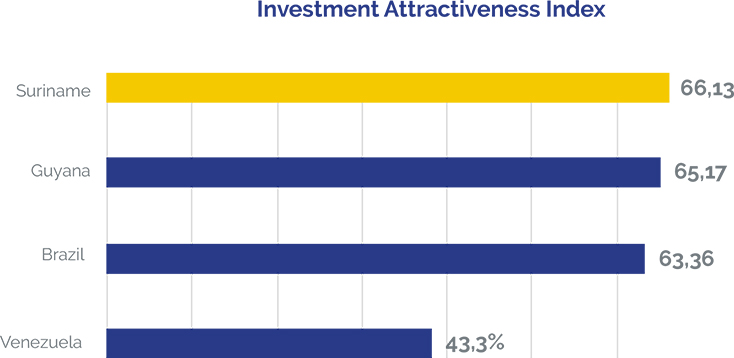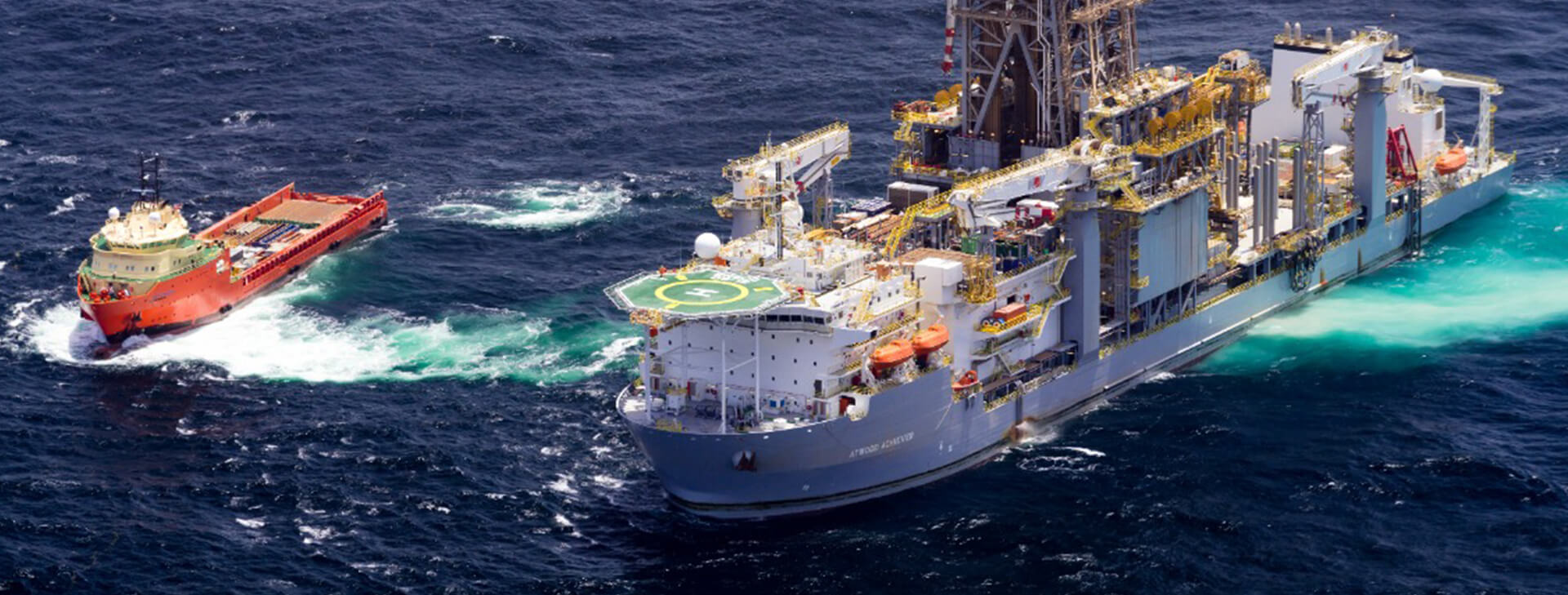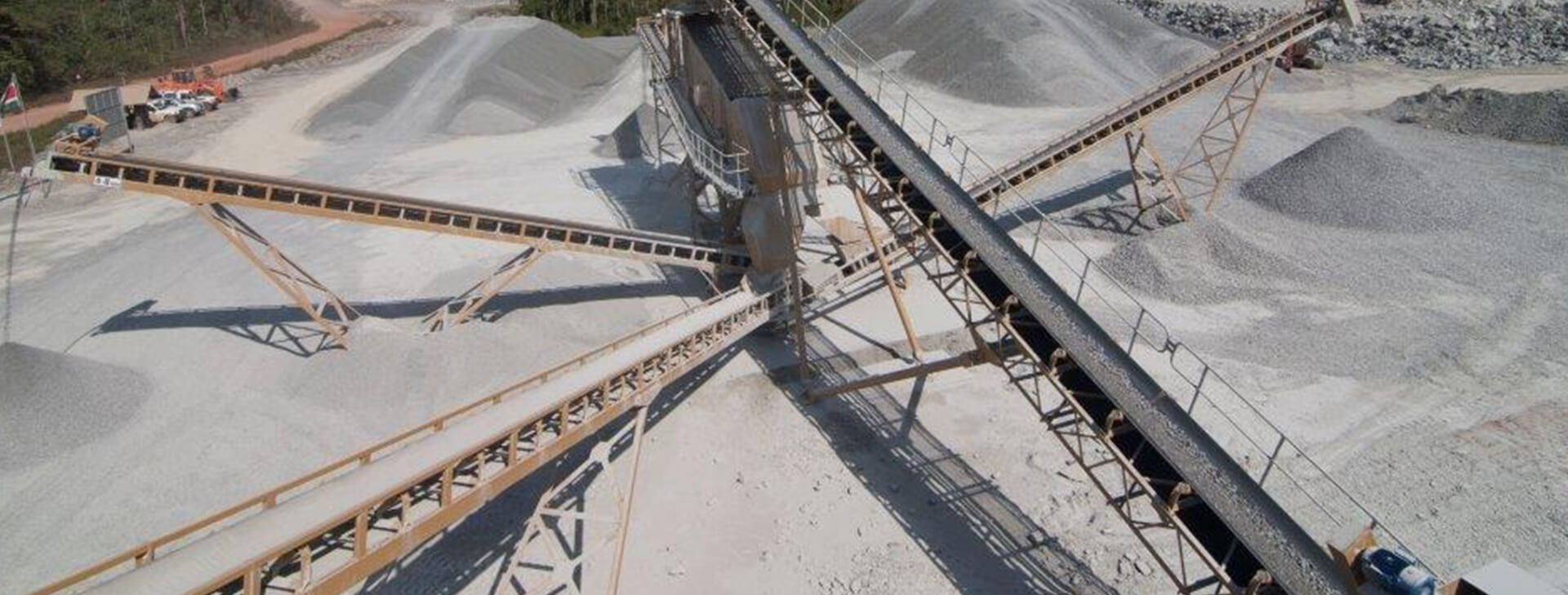Natural Resources
- Home
- Sectors: Invest & Trade
- Natural Resources
PRIORITY SECTORS
Suriname: a land of natural wealth
Suriname belongs to the Precambrian Guiana Shield, a 2 billion years’ old geological formation, which extends for 415.000 km2 from Venezuela to the Amazon River in Brazil.
During the last centuries, several explorations have demonstrated that there is a high potential and clear prospects for the extraction of a range of natural resources in the country, mainly (but not limited to) gold and oil and gas.
SECTORS: natural resources
Competitive advantages
GREEN ENERGIES:
Due to its geographical and climate characteristics, the country is ideal for the generation of different kind of sustainable energies.
Because of it, the government is totally committed with the consolidation of the sustainable energy sector and is about to launch a procurement process for the bidding of studies and pre-investment field works for the generation of solar, wind and biomass energy at a commercial level.
OIL AND GAS:
Due to recent discoveries, Suriname has become the most promising new oil hot spot in the region. Explorations have been reactivated as the Basivn has an estimated potential of:
15,2 billion barrels of crude oil,
1.190,86 cubic meters of gas and
2.329,62 million barrels of natural gas liquids
MINING:
The Investment Attractiveness Index calculated by the Fraser Institute, measures the geologic attractiveness of a jurisdiction as well as the effects of government policy on attitudes toward exploration investment (onerous regulations, taxation levels, quality of infrastructure, etc.).
According to the 2019 Survey of Mining Companies, Suriname is the most attractive country in the Precambrian Guiana, being ranked as the 37th most attractive country from the 76 analyzed territories, above Guyana (39th), Brazil (46th) and Venezuela (70th) .

SECTORS: natural resources
Main resources
Green energies :
Due to its geographical characteristics, Suriname possesses a great potential for the development of businesses related to:
Solar energy: the country has an average rate of 2.542 hours of sunshine per year . Moreover, the Sun is rarely entirely absent, especially during the
long dry season, and provides a global radiation from an average of 450 watt/m.Biomass: its production will certainly play an important role in the near future due to the favorable circumstances for the agrarian production of crops such as Jatropha, sugarcane, oil palm, coconut, elephant grass and rice, as well as to the climatological circumstance that benefits the cultivation
of algae.Hydropower: due to the existence of four major rivers with large volumes of tidal water and strong tidal currents, there is room for installing
micro-hyrdropower plants along big rivers and in the direct surrounding of several villages in the interior.Wind energy: studies are still under development, but there are signs indicating that the coastal and offshore areas may offer ideal conditions for the
installation of windmills .Value chain for the generation of sustainable energies: Taking into account the ideal geographical and climate characteristics of Suriname as well as the liberalization that the green energies’ self-consumption market has, opportunities exist for the whole value chain related to the production and
commercialization of goods and services linked to it.Energy efficiency in buildings: the renewal and rehabilitation of buildings in order to improve their energetic efficiency is an emergent market in Suriname.
Gold:
The extraction of natural resources has been a lead sector since gold was discovered in 2004. Even if most of it can be found in the eastern part of Suriname, within the Greenstone Belt, reserves are also available in the west.
In the last decades, gold has turned into a major economic source for the country, being its key exporting product:
Average value of exports (2016/2020): 1.494.610 thousand USD/year.
Main destination countries: Switzerland, United Arab Emirates, Belgium and the United States of America.
Competitive advantages:
Gold purity: Suriname gold typically is 92 to 93 percent pure (after removing impurities)
Human resources: existence of local workforce with experience in mining
Supported skills development: existence of scientific-training programs such as the Het Natuurtechnisch Instituut
Large gold reserve: valued at approximately 4.2 million ounces, good for a production period of 11 to 13 years
Fiscal terms for large-scale gold mines are essentially negotiable: royalty payments are determined on a case-to-case basis through their specific agreement with the Republic of Suriname.
Royalties for small-scale gold: fixed at 1% , lower than the rates in neighboring countries.
Types of activities with potential: the country offers a wide variety of services for this large supply chain: melting, assaying, evaluation, vaulting, bullion trading, coins, medallions and investment bars distribution, global logistics, and liability coverage and insurance for the international transportation of precious metals
Oil and Gas:
Oil was first discovered in Suriname in 1928 on the coastal plain, close to the western border, but systematic exploration both onshore and offshore only started in the 1960s, when various international oil companies (IOCs) became interested. Oil became the primary industry by the mid-1990s, overtaking bauxite. Total oil production in the last 35 years reached 100 million barrels of crude oil and, in parallel, has boosted the total value of exports:
Average value of oil exports (2016/2020): 91.500 thousand USD/year.
Main destination countries: Guyana, France and United States of America.
Competitive advantages:
New oil hot spots: Suriname is rapidly growing as a key hotspot in the Caribbean region, as recent discoveries in offshore Blocks 52 and 58 have detected new wells with excellent oil properties (an API gravity ranging from 27º to 37º). Moreover, even if three reserves are still under evaluation, the prospections performed until 2021 show reserves accounting for more than 1.300 million barrels.
Active exploration: exploration onshore and offshore has been taken up in order to compensate the under-exploration of the Suriname-Guyana Basin . The United States Geological Survey (USGS) ranked in 2000 the Guyana Suriname Basin as the 2nd in terms of prospectivity among the world’s unexplored basins and estimated its potential in:
– 15.2 billion barrels of crude oil,
– 42.058,37 billion cubic feet / 1.190,86 cubic meters of gas and
– 2,329.62 million barrels of natural gas liquids.Low production costs: about 30 or 40 dollars / 26,5 or 35,4 € per barrel
Supported skills development: existence of training and management programs and initiatives such as: the Master’s Program in Petroleum Geology in the Anton de Kom Universiteit van Suriname or Hydrology and Engineering in the Polytechnic College of Suriname
Wider shared production agreements: they last for 5 to 10 more years than other Latin-American countries
Large production of oil: allows the country to have high levels of primary energy self-sufficiency. The result is very low electricity price at around 7
cents per kWhSignificant spin-off industry around oil
Types of activity with potential: exploration companies, prime contractors, subcontractors, service providers, consulting, investment firms, among others.
Forestry:
Due to the fact that 93% of the country is forested, forestry is a sector with great potential.
The average export value of the wood in the rough or roughly squared between 2016 and 2020 is of 111.327 thousand USD.
Most of the exports are destined to India and China.
According to the Revealed Comparative Advantage (RCA) calculated by the UNCTAD for the country in 2019, Suriname is a competitive producer and exporter of wood in the rough and roughly squared (RCA of 68) and wood simply worked and railway sleepers of food (RCA of 2.2).

SECTORS: natural resources
Other resources with potential:
GREEN ENERGIES:
According to the Revealed Comparative Advantage (RCA) calculated by the UNCTAD for the country in 2019, Suriname is a competitive producer and exporter of the following products linked to natural resources:
| PRODUCT (group digit and name) | RCA |
| 247 Wood in the rough or roughly squared | 68 |
| 248 Wood simply worked and railway sleepers of wood | 2.2 |
| 288 Non-ferrous base metal waste and scrap, n.e.s | 1,6 |
| 273 Stone, sand and gravel | 1,3 |
Bauxite:
Bauxite became predominant after the 1920s due to the need of the United States after World War I. With the development of the Paranam refinery industry and the hydro-electric power by Alcoa, Suriname was, for a long time, one of the main bauxite and alumina producers in the world.
Significant bauxite deposits remain in Suriname, estimated at approximately 64,6 million Mt , but they have been unexploited for the past years. The deposits in the coastal lowlands, formed on sedimentary parent rocks, are almost mined out but those in the plateau, originated on metamorphic rocks, have not been brought into production up to date.
Diamond :
Experts believe that the southeast part of the country are the most promising areas for this activity.
Four types of diamonds in Suriname:
the scattered, well-preserved microdiamonds;
the diamonds from the Sipaliwini area, associated with Dalbana metarhyolites;
the diamonds from the Lawa River region, associated with the Dachine ultrabasic (kimberlitic) body in French Guyana;
the ‘larger’ Rosebel-Sabanpassie diamonds
Kaolin : There are large deposits of kaolin under the bauxite deposits of Moengo and Onverdacht and numerous smaller deposits in the interior of Suriname
Crushed stone:
Crushed stone, such as granite, gneiss, amphibolite and greenstone, are readily available in the interior of Suriname.
Sand:
The country possesses several spots with high-quality resources near Zanderij and Lelydorp, used in the production of glass, as well as in the Coropina Formation and in the Young Coastal Plain of Suriname, often mined for construction purposes.
Kyanite:
Suriname possesses a kyanite deposit near Bosland, just northeast of Lake Brokopondo, with an estimation varying from 3 million tons to 0.5 million tons.
Phosphate:
a copper/phosphate prospect has been detected in Bakhuis. The prospect, referred to as the K/3 area, is 1.5 km long, and is believed to be of sedimentary origin.
Manganese:
Investigations have revealed that manganese occurs in several places in Suriname: the vicinity of the Sarakreek along the Suriname River, along the Tapanahony River and around Apoema Soela on the left bank of the Maraowijne River.
Rare earth elements:
The mineral monazite—one of the main sources of rare earth elements—occurs in several locations in Suriname. Also, indications of rare earth elements such as neodymium, cerium, scandium, and yttrium in Bakhuis have been found.

SECTORS: natural resources
Support
Suriname Investment and Trade Agency (SITA) is the national Trade and Investment Promotion Agency (TIPA) and is comitted to be the strategic and the trusted partner of anyone who wants to do business in Suriname. Need support? Contact us here.
A. RELEVANT ENTITIES
The Ministry of Natural Resources is responsible for policy relating to the exploration and exploitation of minerals, while several other government agencies are responsible for policy relating to mining: Ministry of Finance and the National Institute for Environment and Development in the Office of the President.
Ministry of land and forest management
Chamber of Commerce and Industry
MINING
The Geologisch Mijnbouwkundige Dienst (GMD/Geological Mining Department)
The Bauxiet Instituut Suriname
Central Bank of Suriname : samples, assays and determines the purity and weight of the gold destined for exports
OIL AND GAS
Staatsolie : Has mining rights to explore for and to produce hydrocarbons in Suriname as an independent operator or with other oil companies. On behalf of the government, Staatsolie assesses the hydrocarbon potential while promoting, contracting, and monitoring the activities of the foreign oil companies. Some other activities of this integrated oil company include refining, marketing, and distributing oil products and producing electricity
Suriname International Petroleum & Gas Summit & Exhibition : event bringing up together regional policymakers, entrepreneurs and local businesses as well as international oil companies, services providers, business experts and investors interested in uncovering potential opportunities in the country’s rapidly expanding upstream, midstream and downstream oil and gas markets.
B. POLICIES
MINING highlights
Mining Decree E.58 (1986): 5 types of mining rights:
Reconnaissance rights for up to 200.000 ha for 2 years, with a possible extension of one additional year
Exploration rights for up to 40.000 ha for 3 years, with the possibility of 2 extensions of 2 years, with a reduction in the area of 25% for each extension.
Exploitation rights for up to 10.000 ha for 25 years, with the possibility to extend the rights for up to 25 years.
Small mining rights for up to 200 ha for 2 years, with the possibility to renew the rights for an additional 2 years
Rights to exploit building materials for up to 400 ha for 5 years, extendable for an additional 5 years
Registered gold buyers are required to provide the Central Bank with monthly and annual reports on purchases and sales. Prices paid by buyers are not regulated although they include a 1% royalty to the Central Bank.
HYDROCARBONS highlights
Concession rights related to petroleum may only be granted to state enterprises (Mining Decree) although these are authorized to enter into agreements with petroleum companies (Petroleum Law). Under the law, Staasolie is the owner of all on- and off-shore rights to petroleum deposit, and it operates, either on its own or in partnership, all petroleum operations. These concession rights operated in partnership are awarded through direct negotiations or as a result of a bidding round. Staatsolie is involved in exploration, exploitation and refining on its own and, through petroleum contracts, it negotiates with international oil companies. Joint ventures with third parties, where Staatsolie has no operator function, are carried out by its subsidiary: Paradise Oil Company.
FORESTRY highlights
Under the Forest Management Act, logging requires a concession that may be short, medium or long-term.
An application for a concession must be made to the SBB (Foundation for Forest Management and Production Control). If the concession relates to more than 5.000 ha the applicant must first apply for an exploration permit and, at least 3 months before the expiry of the exploration permit, apply for a logging concession.
C. AVAILABLE INCENTIVES:
The 2001 Investment Act grants incentives for entrepreneurs in the field of mining and forestry who keep regular accounts on their operations (with annual closings) and who, in a year, invest in operating assets intended to be used within the framework of the enterprise.
The specific incentives are:
Free write offs: when computing the profit enjoyed in a year for the profit of levying income tax, the amount of the investment (in operating assets) shall be depreciated arbitrarily.
Exemption from income tax: The profit enjoyed in the commencement year of an enterprise (and the following 9 years) shall be exempted from income tax if certain requirements are met.
Exemption from import duties: the import of capital goods can be partially exempted from import duties, turnover tax and statistics levy if certain conditions are met.
Also, the Petroleum Act states that state-owned enterprises are entitled to enter into petroleum agreements with third parties after approval by the Minister of Natural Resources. Both State-owned enterprises and contractors shall be exempt from import and export duties for the import and export of business assets, materials, goods or equipment of any kind used for petroleum operations, if certain requirements are met. Moreover, the statistical and consent fee payable in respect of the import and export of goods is limited.

 15,2 billion barrels of crude oil,
15,2 billion barrels of crude oil, The Ministry of Natural Resources is responsible for policy relating to the exploration and exploitation of minerals, while several other government agencies are responsible for policy relating to mining: Ministry of Finance and the National Institute for Environment and Development in the Office of the President.
The Ministry of Natural Resources is responsible for policy relating to the exploration and exploitation of minerals, while several other government agencies are responsible for policy relating to mining: Ministry of Finance and the National Institute for Environment and Development in the Office of the President.